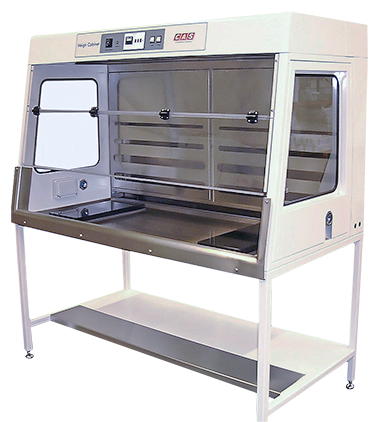
Advice guides
Laminar Flow Cabinets
Laminar Flow Cabinets
Uses and Benefits – Information Guide
Laminar Flows
Laminar air flows can maintain a working area devoid of contaminants. Many medical and research laboratories require sterile working environments in order to carry out specialised work. Laminar Flow Cabinets can provide the solution.

Why Laminar Flow Cabinets?
Laminar Flow Cabinets create particle-free working environments by projecting air through a filtration system and exhausting it across a work surface in a laminar or uni directional air stream. They provide an excellent clean air environment for a number of laboratory requirements.
How They Are Made
Laminar Flow Cabinets, or Laminar Air Flow Cabinets as they are also known, are normally made of stainless steel with no gaps or joints, thereby preventing the build up of bacteria from collecting anywhere in the working zone.
Laminar Flow Cabinets are also known as Clean Benches, because the air for the working environment is thoroughly cleaned by the precision filtration process.
Uses
Laminar Flow Cabinets are suitable for a variety of applications and especially where an individual clean air environment is required for smaller items, e.g., particle sensitive electronic devices.
In the laboratory, Laminar Flow Cabinets are commonly used for specialised work. Laminar Flow Cabinets can be tailor-made to the specific requirements of the laboratory and are also ideal for general lab work, especially in the medical, pharmaceutical, electronic and industrial sectors.
How They Work
The process of laminar air flow can be described as airflow where an entire body of air flows with steady, uniform velocity.
Laminar Flow Cabinets work by the use of in-flow laminar air drawn through one or more HEPA filters, designed to create a particle-free working environment and provide product protection. Air is taken through a filtration system and then exhausted across the work surface as part of the laminar flows process.
Commonly, the filtration system comprises of a pre-filter and a HEPA filter. The Laminar Flow Cabinet is enclosed on the sides and constant positive air pressure is maintained to prevent the intrusion of contaminated room air.
Types of Laminar Flow Cabinets
Laminar Flow Cabinets can be produced as both horizontal and vertical cabinets. There are many different types of cabinets with a variety of airflow patterns for different purposes:
- Vertical Laminar Flow Cabinets
- Horizontal Laminar Flow Cabinets
- Laminar Flow Cabinets and Hoods
- Laminar Flow Benches and Booths
All ensure a workspace devoid of contaminants and may be tailored to the lab requirements.

Horizontal Laminar Flow Cabinets
Horizontal Laminar Flow Cabinets receive their name due to the direction of air flow that comes from above but then changes direction and is processed across the work in a horizontal direction. The constant flow of filtered air provides material and product protection.
Vertical Laminar Flow Cabinets
Vertical Laminar Flow Cabinets function equally well as horizontal Laminar Flow Cabinets, with the laminar air directed vertically downwards onto the working area. The air can leave the working area via holes in the base. Vertical flow cabinets can provide greater operator protection.
Need more information about Laminar Flow Cabinets?
It's true that it can be confusing sometimes understanding the difference between different types of Laminar Flow Cabinets as well as the difference between Microbiological Safety Cabinets and other types of ventilated cabinet, such as Laminar Flow Cabinets.
Significantly, it should be known that Laminar Flow Cabinets are normally produced to protect the working area only. They do not offer operator protection and are not suitable for working with bio-hazards.
When choosing a Laminar Flow Cabinet, it is important to be certain about the type of Laminar Flow Cabinet that you require and to assess it is the right equipment for the work processes it will be used in conjunction with.

Meeting standards
Contained Air Solutions is an ISO 9001 accredited company and a member of the Scottish Society for Contamination Control (S2C2) and the British Standards Institute (BSi).
Contact us
For more information on our safety cabinets, robotics and enclosures, or service and spares department, please fill out our contact form or call us on +44 (0)161 655 8860 for an informal chat or meeting.


